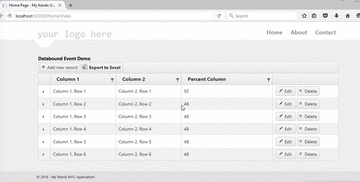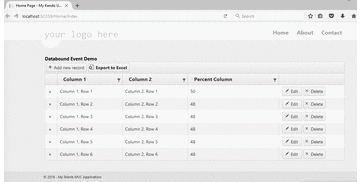The Kendo UI Grid is one of the most versatile grids on the market today. The flexibility and usefulness is unparalleled and thus it is a staple in my web development toolkit. One of my more popular use cases involves providing a Grid of data, where you can select a row and “drill in” or “expand” into to see additional details. Sometimes those details are another grid, sometimes it is simply another view. Kendo makes this super easy and it is demo’ed on their site here: http://demos.telerik.com/kendo-ui/grid/detailtemplate
One of the most common use cases I come across using the grid consist of the following. The user selects and item in the grid, expands the row to "Drill In" to the details. The user then navigates away from the page and when they come back they expect the grid to be in the same state. Unfortunately, without a little extra work this is not possible. Out of the box, when you navigate back to the page the grid will have defaulted back to its default state with all rows collapsed. Here is a demonstration of this in action:
Here is the high-level plan of attack:
- Save a unique value from each record as it is expanded.
- Each time the grid loads, check for the value.
- If present, expand saved row.
To accomplish step one, we are going to need to hook into one of the many Kendo UI events. In this case, we are going using the DetailExpand event to call some custom javascript that will grab the expanded row and post it back to our controller in order to stash it in the session. The DetailExpand event is detailed here: http://docs.telerik.com/kendo-ui/api/javascript/ui/grid#events-detailExpand
1 | .Events(events => events.DetailExpand("GridExpanded")) |
Now our grid will call the GridExpanded() JavaScript function each time a row in the Grid is expanded. This function will have two jobs. First, grab a unique value identifying the row, then post that value to our controller.
1 | function GridExpanded(e) { |
There is a lot packed into this one line function. We are using the JQuery POST function, in order to do an HTTP Post with the data back to the controller. To get the URL we are posting to, we are using the very handy ASP.net MVC URL helper, @URL.action. This method takes the name of the Action and Controller and returns the appropriate relative URL. We are then providing the POST a callback function to provide the data. In this case we are posting a name value pair named rowident where the value is the id column of our grid row. Notice we are using the sender information passed to us from the grid to get the dataItem, and then use the dataItem to get the id. In this example the id column is a unique value in each row. This could be any column, so long as it is unique.
The JavaScript is only one side of the equation. The script is posting the unique row value to our controller via the SetExpandedRow action. We now need to define the action that will catch this value and stash in the session.
1 | [HttpPost] |
Here we are simply throwing the expanded value in the session. You may need to persist this in some other manner depending on your requirements.
Now that we have the last expanded row value stashed in the session we need have the Grid check each time it loads it data. If we have a selected row value, then we need to expand that row. We will do this by using the DataBound event.
1 | .Events(events => events.DetailExpand("GridExpanded").DataBound("ExpandStashedSite")) |
Each time the Grid fires its DataBound event it will now execute our JavaScript function, ExpandStashedSite().
1 | function ExpandStashedSite(e) { |
This function uses JQuery selectors to get our Grid. It then gets the data currently loaded to the grid and starts looping through the records. It checks each records id column to see if it matches our stashed value which it is simply grabbing from the session. If it matches, then it uses the grids expandRow function.
When you put it all together it looks like this:
Notice that when you navigate back to the grid page, it retains the expanded grid. This example was a simple one where we only stash the last expanded row. However, it would be trivial to modify this code to retain all expanded rows.
Here is what the view looks like when you have it all together.
1 | @{ |


